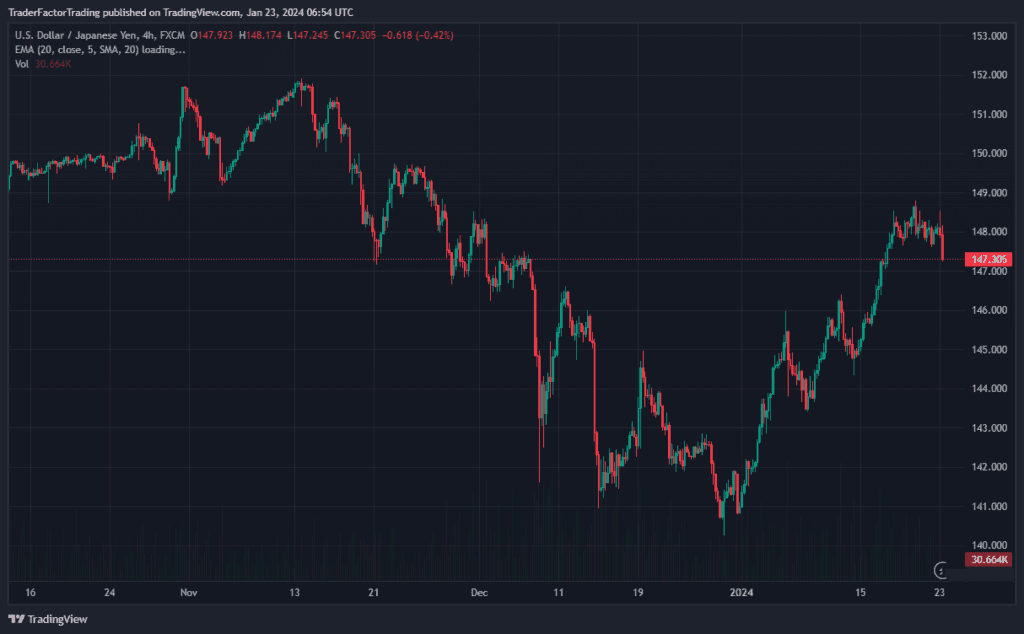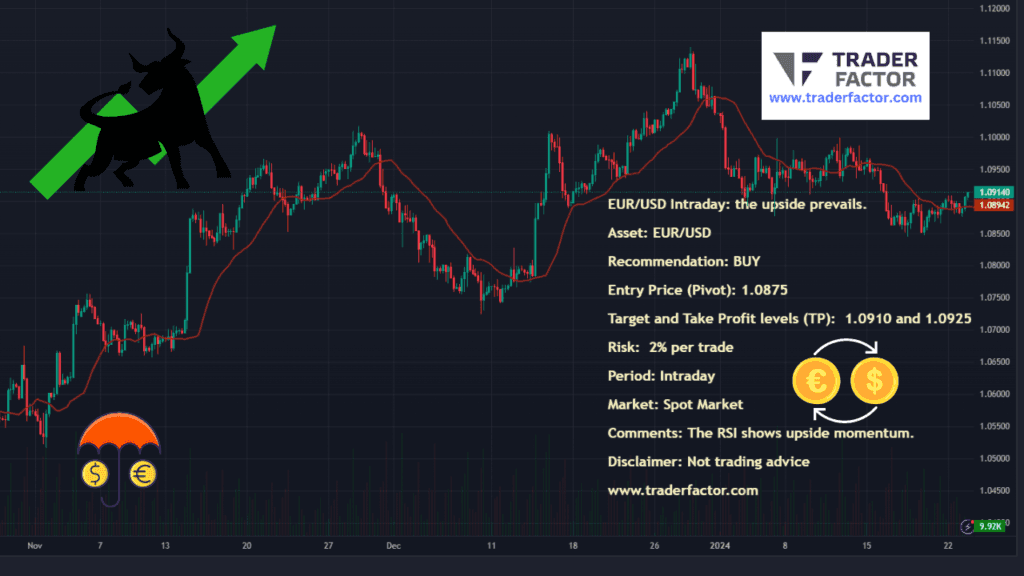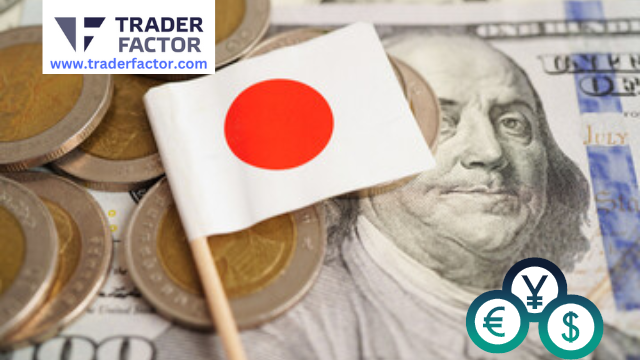In its first meeting of the year, the Bank of Japan (BOJ) predictably maintained its ultra-loose monetary policy. The BOJ unanimously agreed to hold interest rates at -0.1% and continued to adhere to its yield curve control policy. This policy caps the 10-year Japanese government bond yield at an upper limit of 1%, according to a policy statement released after a two-day meeting.
Market Reactions and Predictions
Following the announcement, yields on the 10-year JGBs saw a slight decrease, while the Japanese yen strengthened by 0.1% against the dollar. The Nikkei 225 equity benchmark momentarily reached a new 33-year high before gains were reduced.
The market consensus currently anticipates that the BOJ will terminate its negative rate regime by April, provided that annual spring wage negotiations indicate a significant increase in wages.
The USD/JPY pair saw some buying activity following the BOJ’s policy announcements, trading at 148.37, an increase of 0.22% on the day.
USDJPY Daily Chart

Inflation Forecasts Revised
The BOJ cut its core inflation forecast for the upcoming fiscal year. The board members adjusted their median growth forecast for core consumer prices (excluding food prices) down to 2.4% for fiscal 2024, which starts in April. This is a decrease from the 2.8% estimated in October. Additionally, the central bank slightly raised the core CPI inflation estimate for fiscal 2025 to 1.8% from the previous forecast of 1.7%.
Economic Projections and Statements
The BOJ believes that wage increases could stimulate consumer spending, leading to more sustainable and steady inflation driven by domestic demand. Despite a slowdown in Japan’s core CPI to 2.3% in December, it has remained above the BOJ’s 2% target for 21 consecutive months.
The BOJ released several statements indicating a balanced economic activity risk, a need to monitor the relationship between wages and prices, and a commitment to continue monetary easing as needed. The bank also reiterated its intention to take additional easing steps if necessary.
Table of Contents
ToggleUSD/JPY Experiences Intraday Rebound
USD/JPY Regains Ground
The US Dollar (USD) against the Japanese Yen (JPY) has managed to regain some ground following recent losses, according to recent data. The currency pair has staged a corrective rebound from its 5-month low of 140.25, which was recorded on December 28, 2023.
Technical Outlook
The technical outlook suggests that the USD/JPY’s rebound could extend through 146.40, although the upside is expected to be limited by a 61.8% retracement. The Relative Strength Index (RSI), a key technical indicator, has moved above 30, indicating a potential continuation of the upward momentum.
Market Speculation
Despite the rebound, the USD/JPY pair remains under pressure, down over six percent from November’s peak.
Intraday Trading Recommendation
For intraday traders, the current market conditions suggest a BUY recommendation for the USD/JPY. The entry price (pivot) is set at 147.60, with target and take profit levels (TP) at 148.55 and 148.80 respectively. Traders should be prepared to risk 2% per trade.

Please note, these recommendations are subject to change due to market volatility.
Euro Rebounds Amid US Dollar Weakness
The Euro (EUR) has made a noticeable recovery against the US Dollar (USD), moving above the 1.0900 mark in the early hours of European trading on Tuesday. The currency pair’s rebound comes after marginal losses posted on Monday and is largely attributed to a renewed weakness in the USD.
Impact of USD/JPY Decline
A sharp decline in the USD/Japanese Yen (JPY) exchange rate has contributed to the weakening of the USD and subsequently aided the EUR/USD’s upward movement. This decline was triggered by relatively hawkish comments from Bank of Japan (BoJ) Governor Kazuo Ueda, following the BoJ’s decision to maintain its current policy settings.
Limited Bullish Momentum for EUR/USD
Despite the weakened USD helping to propel the EUR/USD upwards, the pair may struggle to breach the 1.0930-1.0935 resistance area unless there is a significant improvement in risk sentiment later in the day. The bearish pressure on the EUR/JPY, which also resulted from capital outflows from the USD, has limited the potential for further bullish momentum in the EUR/USD.
Upcoming Consumer Confidence Data
Later today, the European Commission will release preliminary Consumer Confidence data for January. However, this is not expected to have a notable impact on the Euro’s valuation.
Intraday Trading Recommendation
For intraday traders, the current market conditions suggest a BUY recommendation for the EUR/USD. The entry price (pivot) is set at 1.0875, with target and take profit levels (TP) at 1.0910 and 1.0925 respectively. Traders should be prepared to risk 2% per trade.

Please note, these recommendations are subject to change due to market volatility.
GBP/USD Ascends for Second Consecutive Session
Positive Trajectory for GBP/USD
The British Pound (GBP) against the US Dollar (USD) has continued its upward trajectory for the second successive session this Tuesday, nudging close to the 1.2740 mark. The Pound Sterling’s strong performance is bolstered by expectations of a status quo in the Bank of England’s (BoE) monetary policy.
Bullish Momentum Building
Early Tuesday saw the GBP/USD gaining traction and moving towards the 1.2750 level. This comes after Monday’s trading session ended virtually unchanged. The near-term technical outlook suggests that bullish momentum is accumulating.
Market Mood Boosts GBP/USD
An optimistic market sentiment has hampered the US Dollar’s ability to gather strength, aiding the GBP/USD’s upward push. A Bloomberg report stating that China is considering a rescue package for the equity market worth around 27 billion USD sparked a rally in Asian equity indexes. Hong Kong’s Hang Seng index, for instance, saw nearly a 3% gain.
Intraday Trading Recommendation
For intraday traders, the current market conditions suggest a BUY recommendation for the GBP/USD. The entry price (pivot) is set at 1.2695, with target and take profit levels (TP) at 1.2745 and 1.2760 respectively. Traders should be prepared to risk 2% per trade.

Please note, these recommendations are subject to change due to market volatility.
Australian Dollar Edges Higher Amid Positive Business Confidence
Aussie Dollar Sees Improvement
The Australian Dollar (AUD) has seen a slight increase on Tuesday, recovering from losses experienced in the previous session. This improvement is potentially due to increased confidence in businesses as reported by the National Australia Bank. Additionally, the AUD has likely been supported by an upturn in the performance of Australia’s share market.
However, the US Dollar (USD) continues to strengthen despite lower US Treasury yields, which could put some pressure on the AUD/USD pair.
Potential Early Interest Rate Cuts
The Australian currency faces challenges due to speculation about potential early interest rate cuts from the Reserve Bank of Australia (RBA). This speculation is fueled by recent indicators such as low Aussie Consumer Confidence and Employment Change figures, leading to concerns about the economic outlook.
Intraday Trading Recommendation
For intraday traders, the current market conditions suggest a BUY recommendation for the AUD/USD. The entry price (pivot) is set at 0.6565, with target and take profit levels (TP) at 0.6615 and 0.6630 respectively. Traders should be prepared to risk 2% per trade.

Please note, these recommendations are subject to change due to market volatility.
Crude Oil (WTI) Intraday: Positive Momentum Expected
Crude Oil’s Market Performance
Crude Oil (WTI) is showing signs of a positive momentum in the intraday trading session. After experiencing a period of volatility, the commodity seems to be finding support around the 74.30 level.
Intraday Trading Recommendation
Given the current market scenario, there is a BUY recommendation for Crude Oil (WTI). The entry price or pivot point is set at 74.30. The target and take profit levels (TP) are projected at 75.30 and 75.80 respectively. Traders should be prepared to risk 1% per trade in this intraday trading scenario.
Market Indicators
The Relative Strength Index (RSI), a key momentum indicator, has just landed on its neutrality area at 50% and is turning upwards. This indicates a potential uptick in buying pressure, which could drive prices higher in the near term.

Please note, these recommendations are subject to change due to market volatility.
Disclaimer:
All information has been prepared by TraderFactor or partners. The information does not contain a record of TraderFactor or partner’s prices or an offer of or solicitation for a transaction in any financial instrument. No representation or warranty is given as to the accuracy or completeness of this information. Any material provided does not have regard to the specific investment objective and financial situation of any person who may read it. Past performance is not a reliable indicator of future performance.
Author

Phyllis Wangui is a skilled Financial Analyst at TraderFactor, specializing in technical and fundamental analysis. She delivers actionable insights and data-driven strategies to optimize trading decisions. Her expertise empowers clients with market trends, risk assessments, and informed financial solutions.
View all posts SEO Editor


















